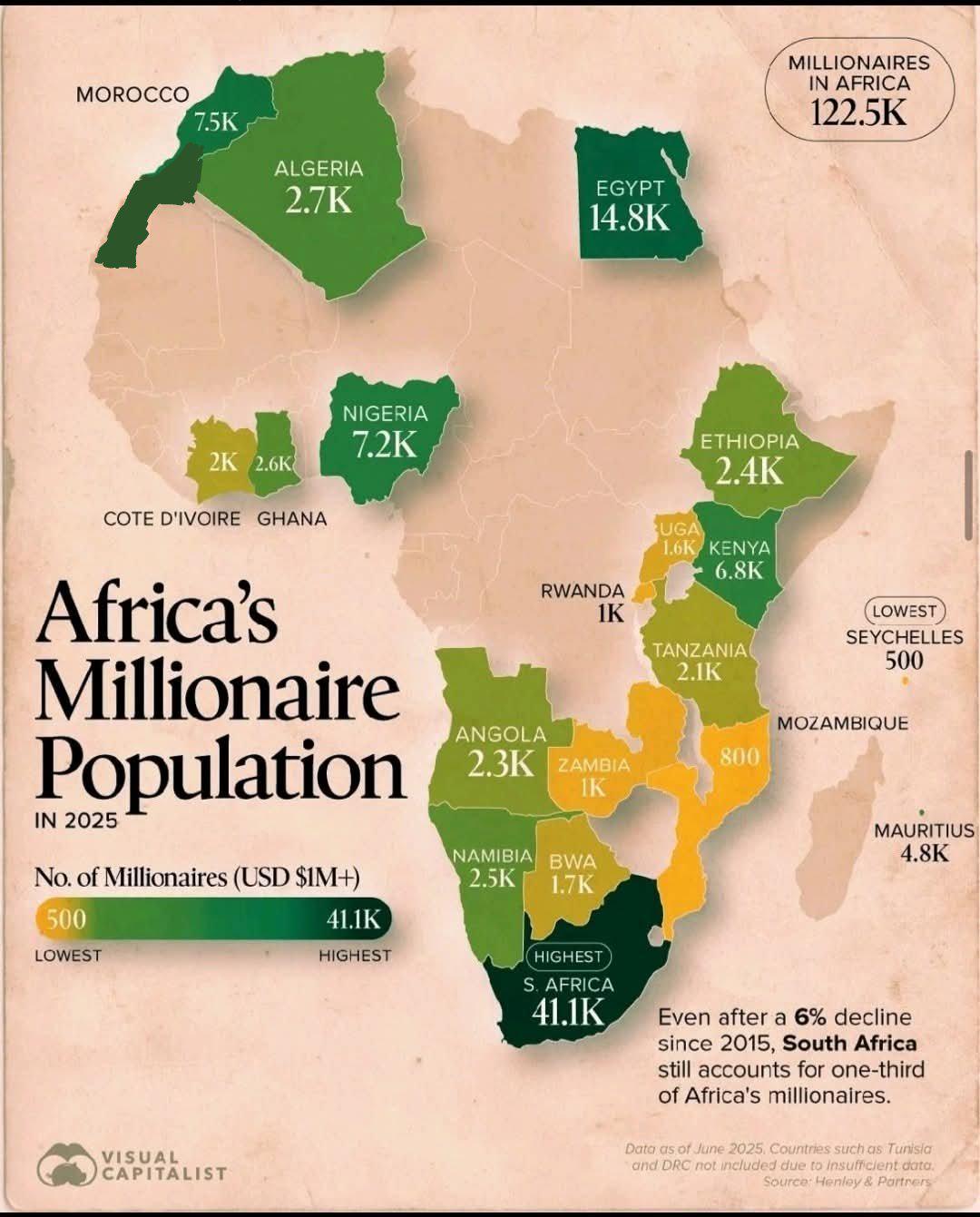Africa's Millionaire Population Map 2025


David Chen
Data Visualization Specialist
David Chen is an expert in transforming complex geographic datasets into compelling visual narratives. He combines his background in computer science ...
Geographic Analysis
What This Map Shows
The visualization titled "Africa's Millionaire Population in 2025" presents a detailed look at the projected number of millionaires across various African nations. By examining this map, we can identify which countries are expected to see significant growth in wealth and how this correlates to economic development on the continent. It’s a snapshot of emerging economies and provides insights into the shifting financial landscape of Africa.
Deep Dive into Africa's Millionaire Population
Africa has long been viewed through the lens of its challenges, but the narrative is changing as the continent experiences economic growth and increasing wealth creation. By 2025, the number of millionaires in Africa is projected to rise significantly, reflecting a broader trend of wealth accumulation driven by economic diversification and technological advancements.
Interestingly, the growth in millionaire populations isn’t uniform across the continent. Countries like Nigeria, South Africa, and Egypt are expected to lead in the number of high-net-worth individuals (HNWIs). For instance, Nigeria's economy, bolstered by its oil and gas sector along with a burgeoning tech industry, is anticipated to produce a substantial number of millionaires. Similarly, South Africa, with its well-established financial services sector, continues to be a hub for wealth accumulation, despite ongoing socio-economic challenges.
Interestingly, wealth creation in Africa is increasingly tied to entrepreneurship. The rise of tech startups, especially in hubs like Nairobi and Lagos, has contributed to the emergence of a new class of millionaires. These entrepreneurs are not just following traditional business models; they are innovating in sectors such as fintech, agriculture, and renewable energy. Have you noticed how many African nations are investing in technology? This is a key factor driving the millionaires' growth.
Moreover, the rise in millionaires can also be attributed to the continent's rich natural resources. Countries like Angola and Botswana have experienced wealth growth due to diamond mining and other mineral extraction industries. However, the challenge remains in ensuring that this wealth translates into broader economic benefits for the population.
Regional Analysis
When we break down the millionaire population map, several regions stand out. West Africa, particularly Nigeria, is projected to have the highest increase in millionaires. As the country’s economy diversifies beyond oil, sectors like agriculture and technology are expected to flourish.
In East Africa, Kenya is on the rise, with a notable increase in millionaires due to its vibrant tech scene and agricultural exports. The presence of innovation centers and investment in startup ecosystems has significantly contributed to this growth.
On the other hand, North Africa, particularly Egypt, also shows promising figures. With its established tourism industry and growing sectors like IT and renewable energy, Egypt is becoming a key player in wealth accumulation. In contrast, some Southern African countries, while historically wealthy due to mining, are facing economic challenges that may hinder millionaire growth. For example, Zimbabwe's economic instability contrasts with its mineral wealth, affecting its potential for producing new millionaires.
Significance and Impact
Understanding the millionaire population in Africa is crucial for several reasons. First, it highlights the economic potential of the continent, which is often overlooked in global narratives. As more millionaires emerge, there’s a possibility for increased investment in local economies, which can lead to job creation and improved living standards.
Moreover, the rise in wealth also brings challenges, such as income inequality and social unrest. Countries must balance supporting wealth generation with ensuring that all citizens benefit from economic growth. Policymakers need to focus on inclusive economic strategies that ensure growth is sustainable and equitable.
What’s fascinating is that the increase in millionaires can also attract foreign investment. Investors are often drawn to regions where wealth is concentrated, viewing it as a sign of stability and growth. This could lead to further economic development and infrastructure improvements across the continent.
As we look ahead to 2025, it’s clear that Africa's economic landscape is evolving. The increase in millionaires signifies not just wealth, but the potential for broader socio-economic transformation. As these trends continue, they will shape the future of Africa and its role in the global economy.
Visualization Details
- Published
- September 30, 2025
- Views
- 40
Comments
Loading comments...